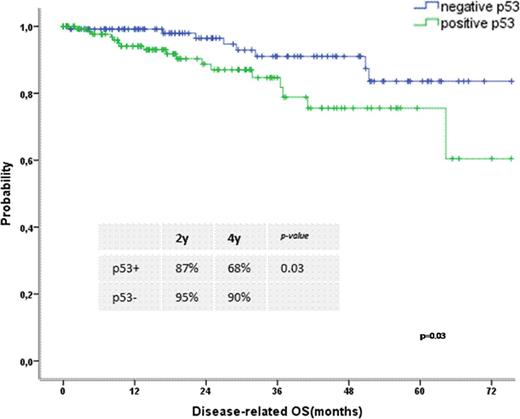Abstract
Background
The presence of diverse spectrum of mutations in myelodysplastic syndromes (MDS) has largely revolutionized the understanding of the disease. Although certain mutations have doubtful prognostic significance, the adverse impact of TP53 mutation is irrefutable in all publications. We and others have shown the strong correlation between presence of TP53 mutation and overexpression of p53 by immunohistochemistry (IHC). This evidence provides the rationale for the evaluation of p53 overexpression which is available in routine diagnostic workup, as a surrogate marker to predict TP53 mutations. Additionally, we predicted that the overexpression of p53 might be an independent prognosticator, even in the absence of TP53 mutations or RPS14 haploinsufficiency, in low risk MDS.
In our study,we analyzed the p53 protein expression in a cohort of 277 'lower risk' MDS patients and compared the clinico-pathological features, overall survival and risk of progression and evolution to AML with respect to p53 IHC status.
Methods
This study enrolled 277 adult low risk MDS patients seen at King's College Hospital between March 2009 and February 2016. All marrow samples were assessed for p53 expression (intensity and proportion of cells) and scored using a Modified Quick Score (MQS). MQS ≥2 was chosen to define p53-positive staining. The median follow-up was 18.7 months [95% confidence interval (CI), 16.5-21.0 months].
Results
According to WHO categories, the predominant group was RCMD (78%). Patients were either IPSS low (n=134, 48%) or int-1 (n=91, 33%). We included 52 (19%) pts for whom the IPSS category was not available, due to the lack or failed cytogenetic data, but these were low-risk WHO categories with no excess of blasts. IPSS-R categories were very low 103 (37%), low 77 (28%), intermediate 38 (14%) and high risk 7 (3%). Overall, 19 (7%) patients progressed to AML and 41 (15%) patients died of which 25 (61%) were disease-related deaths.
Of the 277 patients, 148 (53%) showed p53 protein expression with MQS ≥ 2 and were considered "p53-positive" patients (p53+). The p53 stain intensity was negative in 125 (45%), weak in 84 (30%), moderate in 40 (14%) and strong in 28 (11%). Seventy six (28%) patients had >5% p53 staining cells.
p53 expression correlated with a higher age at diagnosis (median age 64 vs. 60 years, p=0.01). lower haemoglobin levels (9.8 vs 11 g/dL, p=0.002), but a higher platelets count (139 vs 99 x109/L, p =.003) (Table 1). This significance persisted even on exclusion of patients with 5q- and MDS/MPN. P53+ did not correlate with any cytogenetic risk group or degree of fibrosis.
Sequencing data was available in 121 patients with 63 harbouring somatic mutations. Among these patients, only 3 showed the TP53 gene mutation; all of them were classified as positive when assessed for p53 stain (MQS≥2), showing that the nuclear staining reflects underlying TP53 mutations in such cases. Additionally, presence of SF3B1 mutation correlated strongly with p53+ (p=0.02).
Patients with p53+ had a significantly shorter OS compared with those with p53- (figure 1a) with 2yr and 4yr survival probability of 87% &68% vs 95% & 90% , respectively (p=0.03 ).
Analysis of progression-free survival (progression to AML, cytogenetic evolution, increase of blasts or fibrosis) showed that patients with p53 expression had a significantly shorter PFS compared to patients without p53 expression (Figure 1b): 2yr & 4yr PFS 70% & 54% vs 85% &75% respectively, p=0.01). Multivariate analysis confirmed the independent prognostic value of p53 expression for PFS (p=0.013, HR 2.6, 95% CI 1.2-5.2).
Conclusion
In conclusion, our study showed that p53 overexpression by IHC, represented as MQS cutoff ≥ 2, correlates with features of poor prognosis, such as more advanced age at diagnosis, lower haemoglobin levels and shorter overall survival, adversely impacting progression-free survival.
p53 IHC in MDS patients may represent an important, easily available, cheap and applicable prognostic tool and it should be considered for auxiliary analysis when determining the therapeutic options for a patient. The p53+ predicts poor outcome, especially disease progression, independent of the TP53 mutation status, indicating an alternate yet undefined pathway for p53 overexpression.
Disease-related OS (a) and PFS (b) in patients with low-risk MDS according to their p53 expression-status
Disease-related OS (a) and PFS (b) in patients with low-risk MDS according to their p53 expression-status
No relevant conflicts of interest to declare.
Author notes
Asterisk with author names denotes non-ASH members.




This feature is available to Subscribers Only
Sign In or Create an Account Close Modal